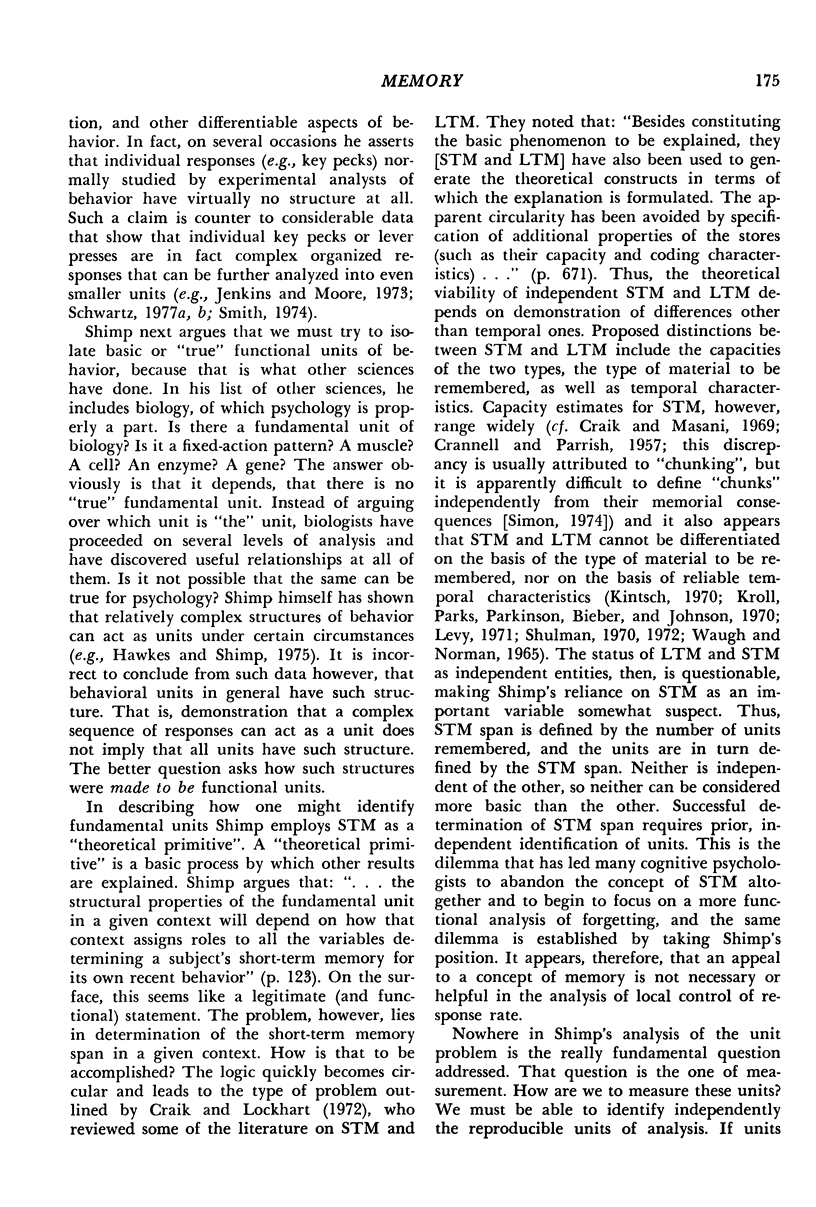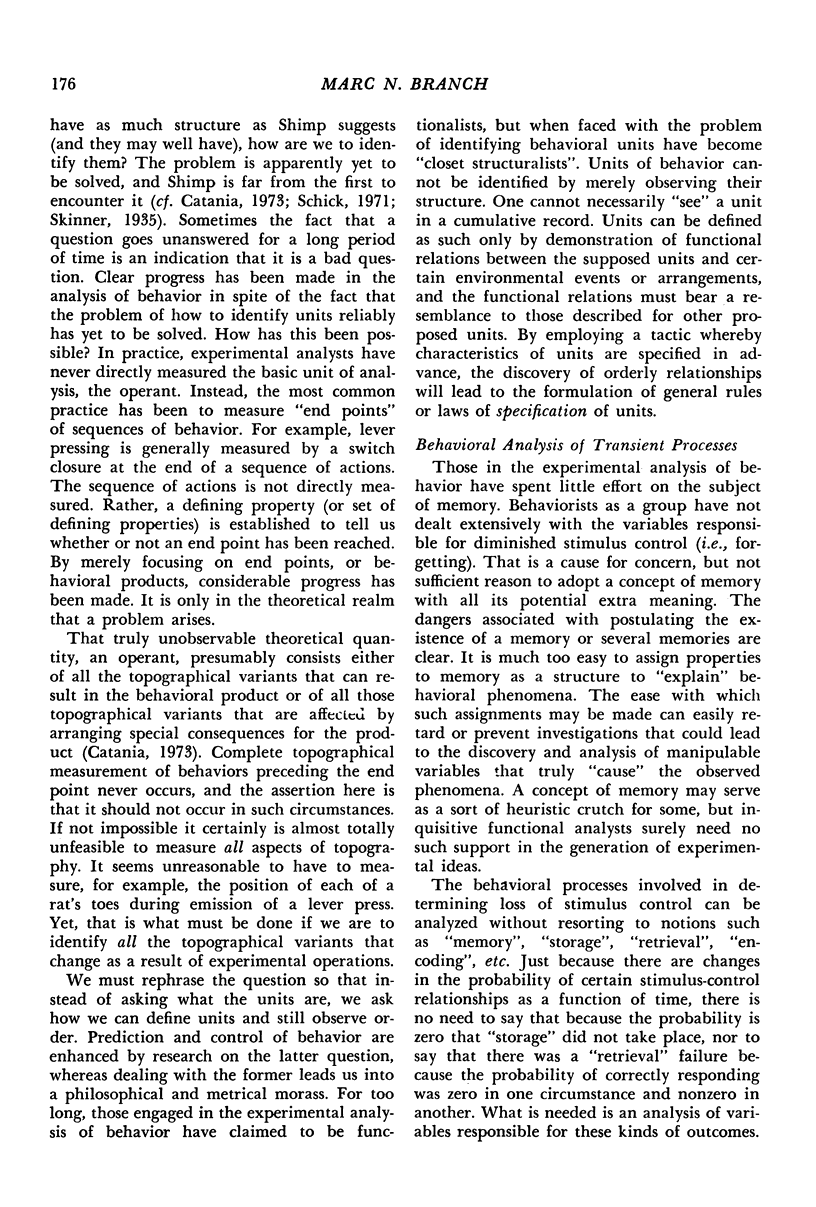Abstract
Shimp's (1976) recent paper on memory and the structure of behavior is discussed, as is the concept of memory itself. Radical behaviorism is distinguished from associationism, and behavioral accounts of experiments on short-term and long-term memory are provided. Unobservable theoretical quantities, such as rate of response, are distinguished from theoretical constructs such as memory. The logical inconsistency involved in the use of short-term memory as a “theoretical primitive” in the definition of units of behavior is explicated, and an alternative strategy for identifying units of behavior is presented. It is argued that the experimental analysis of behavior has ignored processes usually considered as memorial because many of the phenomena are irreversible. Methods for the study of transitions in single subjects should be developed more fully. Possible pitfalls associated with subscription to the term memory are listed, and it is concluded that the concept is neither required nor helpful in the analysis of behavior.
Keywords: memory, short-term memory, operants, radical behaviorism, transition states
Full text
PDF








Selected References
These references are in PubMed. This may not be the complete list of references from this article.
- Anger D., Anger K. Behavior changes during repeated eight-day extinctions. J Exp Anal Behav. 1976 Sep;26(2):181–190. doi: 10.1901/jeab.1976.26-181. [DOI] [PMC free article] [PubMed] [Google Scholar]
- Boren J. J., Devine D. D. The repeated acquisition of behavioral chains. J Exp Anal Behav. 1968 Nov;11(6):651–660. doi: 10.1901/jeab.1968.11-651. [DOI] [PMC free article] [PubMed] [Google Scholar]
- Boren M. C., Gollub L. R. Accuracy of performance on a matching-to-sample procedure under interval schedules. J Exp Anal Behav. 1972 Jul;18(1):65–77. doi: 10.1901/jeab.1972.18-65. [DOI] [PMC free article] [PubMed] [Google Scholar]
- Dunham P. J., Mariner A., Adams H. Enhancement of off-key pecking by on-key punishment. J Exp Anal Behav. 1969 Sep;12(5):789–797. doi: 10.1901/jeab.1969.12-789. [DOI] [PMC free article] [PubMed] [Google Scholar]
- FERSTER C. B. Intermittent reinforcement of matching to sample in the pigeon. J Exp Anal Behav. 1960 Jul;3:259–272. doi: 10.1901/jeab.1960.3-259. [DOI] [PMC free article] [PubMed] [Google Scholar]
- FINDLEY J. D. An experimental outline for building and exploring multi-operant behavior repertoires. J Exp Anal Behav. 1962 Jan;5(Suppl):113–166. doi: 10.1901/jeab.1962.5-s113. [DOI] [PMC free article] [PubMed] [Google Scholar]
- Hawkes L., Shimp C. P. Reinforcement of behavioral patterns: shaping a scallop. J Exp Anal Behav. 1975 Jan;23(1):3–16. doi: 10.1901/jeab.1975.23-3. [DOI] [PMC free article] [PubMed] [Google Scholar]
- Hobson S. L. Discriminability of fixed-ratio schedules for pigeons: effects of absolute ratio size. J Exp Anal Behav. 1975 Jan;23(1):25–35. doi: 10.1901/jeab.1975.23-25. [DOI] [PMC free article] [PubMed] [Google Scholar]
- Jenkins H. M., Moore B. R. The form of the auto-shaped response with food or water reinforcers. J Exp Anal Behav. 1973 Sep;20(2):163–181. doi: 10.1901/jeab.1973.20-163. [DOI] [PMC free article] [PubMed] [Google Scholar]
- Kroll N. E., Parks T., Parkinson S. R., Bieber S. L., Johnson A. L. Short-term memory while shadowing: recall of visually and of aurally presented letters. J Exp Psychol. 1970 Aug;85(2):220–224. doi: 10.1037/h0029544. [DOI] [PubMed] [Google Scholar]
- LANE H. Temporal and intensive properties of human vocal responding under a schedule of reinforcement. J Exp Anal Behav. 1960 Jul;3:183–192. doi: 10.1901/jeab.1960.3-183. [DOI] [PMC free article] [PubMed] [Google Scholar]
- MARGULIES S. Response duration in operant level, regular reinforcement, and extinction. J Exp Anal Behav. 1961 Oct;4:317–321. doi: 10.1901/jeab.1961.4-317. [DOI] [PMC free article] [PubMed] [Google Scholar]
- MURDOCK B. B., Jr The retention of individual items. J Exp Psychol. 1961 Dec;62:618–625. doi: 10.1037/h0043657. [DOI] [PubMed] [Google Scholar]
- NOTTERMAN J. M., MINTZ D. E. Exteroceptive cueing of response force. Science. 1962 Mar 23;135(3508):1070–1071. doi: 10.1126/science.135.3508.1070. [DOI] [PubMed] [Google Scholar]
- Platt J. R., Kuch D. O., Bitgood S. C. Rats' lever-press durations as psychophysical judgements of time. J Exp Anal Behav. 1973 Mar;19(2):239–250. doi: 10.1901/jeab.1973.19-239. [DOI] [PMC free article] [PubMed] [Google Scholar]
- Pliskoff S. S., Goldiamond I. Some discriminative properties of fixed ratio performance in the pigeon. J Exp Anal Behav. 1966 Jan;9(1):1–9. doi: 10.1901/jeab.1966.9-1. [DOI] [PMC free article] [PubMed] [Google Scholar]
- RILLING M., MCDIARMID C. SIGNAL DETECTION IN FIXED-RATIO SCHEDULES. Science. 1965 Apr 23;148(3669):526–527. doi: 10.1126/science.148.3669.526. [DOI] [PubMed] [Google Scholar]
- Schick K. Operants. J Exp Anal Behav. 1971 May;15(3):413–423. doi: 10.1901/jeab.1971.15-413. [DOI] [PMC free article] [PubMed] [Google Scholar]
- Schwartz B. Two types of pigeon key pecking: suppression of long- but not short-duration key pecks by duration-dependent shock. J Exp Anal Behav. 1977 Mar;27(2):393–398. doi: 10.1901/jeab.1977.27-393. [DOI] [PMC free article] [PubMed] [Google Scholar]
- Shimp C. P. Organization in memory and behavior. J Exp Anal Behav. 1976 Jul;26(1):113–130. doi: 10.1901/jeab.1976.26-113. [DOI] [PMC free article] [PubMed] [Google Scholar]
- Simon H. A. How Big Is a Chunk?: By combining data from several experiments, a basic human memory unit can be identified and measured. Science. 1974 Feb 8;183(4124):482–488. doi: 10.1126/science.183.4124.482. [DOI] [PubMed] [Google Scholar]
- Skinner B. F. Farewell, My LOVELY! J Exp Anal Behav. 1976 Mar;25(2):218–218. doi: 10.1901/jeab.1976.25-218. [DOI] [PMC free article] [PubMed] [Google Scholar]
- Smith R. F. Topography of the food-reinforced key peck and the source of 30-millisecond interresponse times. J Exp Anal Behav. 1974 May;21(3):541–551. doi: 10.1901/jeab.1974.21-541. [DOI] [PMC free article] [PubMed] [Google Scholar]
- TULVING E. INTRATRIAL AND INTERTRIAL RETENTION: NOTES TOWARDS A THEORY OF FREE RECALL VERBAL LEARNING. Psychol Rev. 1964 May;71:219–237. doi: 10.1037/h0043186. [DOI] [PubMed] [Google Scholar]
- TULVING E. Subjective organization in free recall of "unrelated" words. Psychol Rev. 1962 Jul;69:344–354. doi: 10.1037/h0043150. [DOI] [PubMed] [Google Scholar]
- WAUGH N. C., NORMAN D. A. PRIMARY MEMORY. Psychol Rev. 1965 Mar;72:89–104. doi: 10.1037/h0021797. [DOI] [PubMed] [Google Scholar]
- Williams D. R. The structure of response rate. J Exp Anal Behav. 1968 May;11(3):251–258. doi: 10.1901/jeab.1968.11-251. [DOI] [PMC free article] [PubMed] [Google Scholar]
- Zeiler M. D. Time limits for completing fixed ratios. J Exp Anal Behav. 1970 Nov;14(3):275–286. doi: 10.1901/jeab.1970.14-275. [DOI] [PMC free article] [PubMed] [Google Scholar]


